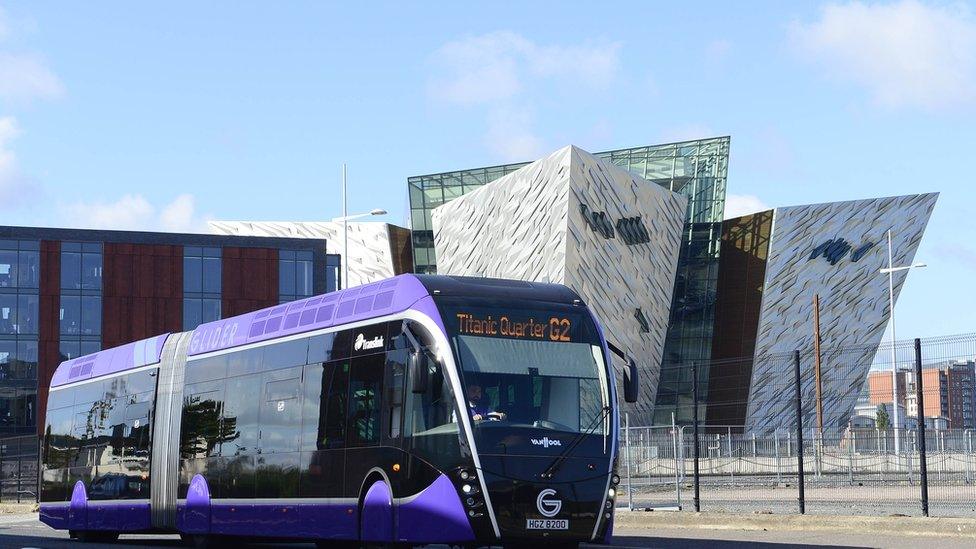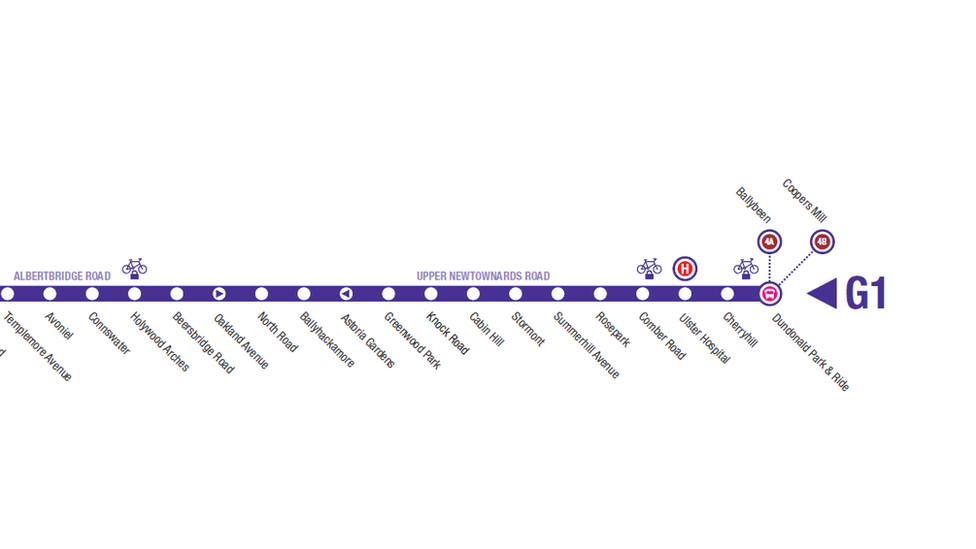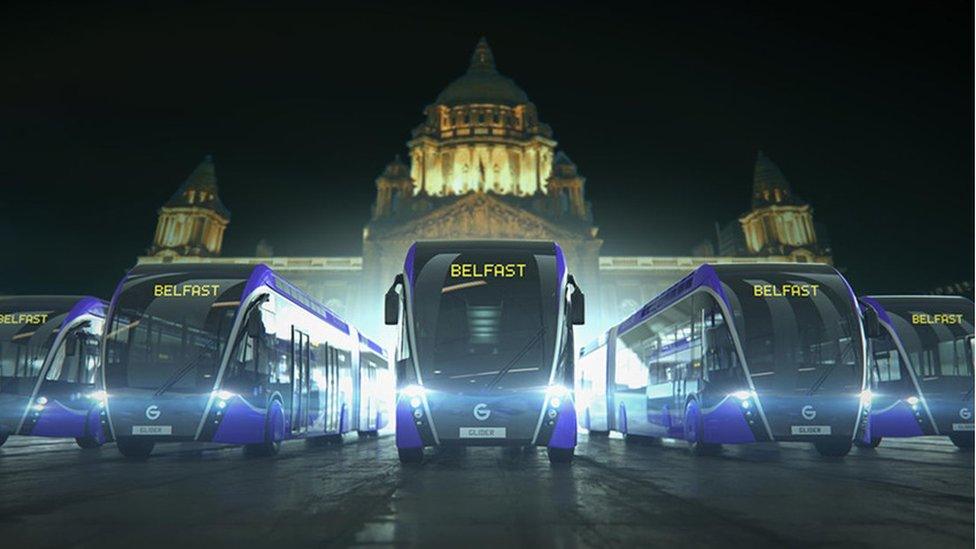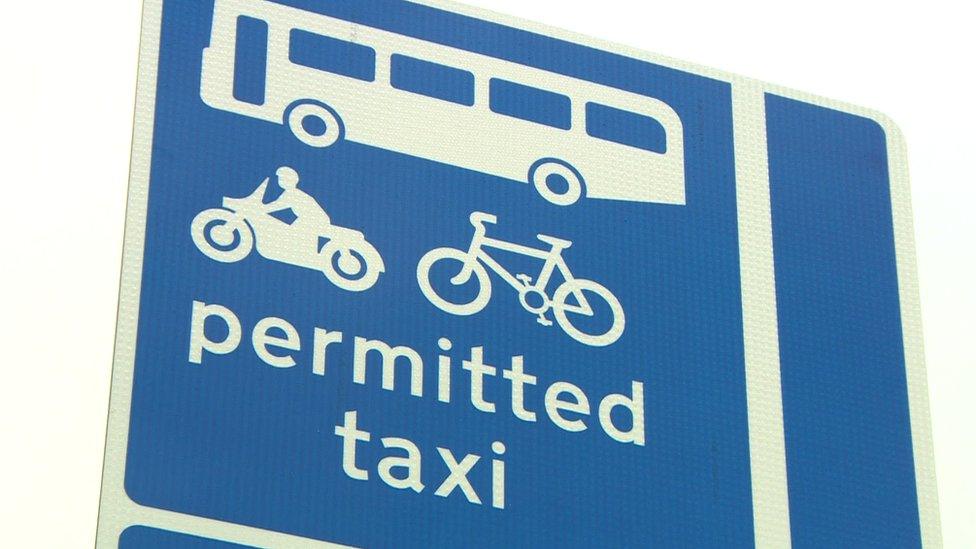Belfast's Glider bus system becomes fully operational
- Published
How to buy a ticket for Belfast's new Glider buses
The new £90m Belfast Rapid Transit Glider service has become fully operational.
The Glider buses have been described as "a tram on wheels".
Allow X content?
This article contains content provided by X. We ask for your permission before anything is loaded, as they may be using cookies and other technologies. You may want to read X’s cookie policy, external and privacy policy, external before accepting. To view this content choose ‘accept and continue’.
They will run about every seven to eight minutes, linking east Belfast, west Belfast and the Titanic Quarter with the city centre.
The Gliders will replace the majority of Metro 4 and 10 services. Bus lanes built for the service will operate from 07:00 BST to 19:00 Monday to Saturday.

Tickets are available from machines at the Glider stops
'Teething problems'
There were some problems on the first day of full service, including complaints that the buses were not coming as regularly as they were meant to and that the real time passenger information system on board was not working properly.
Translink chief executive Chris Conway told BBC Radio Ulster that these were 'teething issues' at one point in the day.
He said: "We had a technical problem with our real time passenger information - that system also controls the bus network.
"There was a glitch in it today and the control room lost visibility but the supplier has assured us that issue has now been fixed."
Some passengers also complained about overcrowding and Translink has said two extra buses will be running tomorrow.
Mr Conway said: "The immediate teething problems - we would like to see a big improvement on Tuesday.
"Within a couple of days we should have a lot of these issues put to bed."
A Translink spokesperson added that the first day of service had gone well "overall".
They said city centre diversions as a result of the fire at the Bank Buildings at the end of August "were also bringing some challenges".


Glider facts
They are 59ft (18m) long and have three doors
They can carry 105 passengers
The service will operate every seven to eight minutes throughout the working day
More than 100 Glider halts have been installed
There are 30 vehicles servicing the route with free onboard wifi and USB charging facilities

Bus lane disruption
The new 12-hour bus lanes were introduced on a phased basis beginning in July.
Last week, it was announced by the Department for Infrastructure that a 12-month scheme allowing private hire taxis to use the lane has been put on hold.
A bus lane introduced in the Titanic Quarter was suspended after motorists complained about "horrendous" tailbacks.
On Monday evening a small protest took place at the front of Belfast City Hall.
Those in attendance included parents, teachers and pupils from St Kevin's Primary School in west Belfast.

In west Belfast, drivers have been warned not to park in the bus lane while dropping children off to school.
There will be a loading and unloading window between 10:00 and 14:00 and vehicles with a blue badge will be allowed to stop in the lanes for up to 10 minutes to drop-off or pick up a blue badge holder.

The Department for Infrastructure has invested £90m in the new service
Funeral corteges are also allowed to use the lanes, which the Department for Infrastructure said would create a "safer environment" for people to walk behind the hearse.
'Modern and efficient'
The Department for Infrastructure invested £90m in the Glider service and hopes it will encourage people to use public transport.

David Sterling, the head of the Northern Ireland Civil Service, said the Glider service "is all about customers and connectivity".
"It offers an enhanced customer experience and a joined up service," he said.
"The new Glider service will offer quick, modern and efficient access into and across the city.
"It will also improve the city's image and help to open up new development opportunities along its routes, linking and regenerating communities and transforming neighbourhoods."
- Published13 December 2017

- Published29 August 2018
